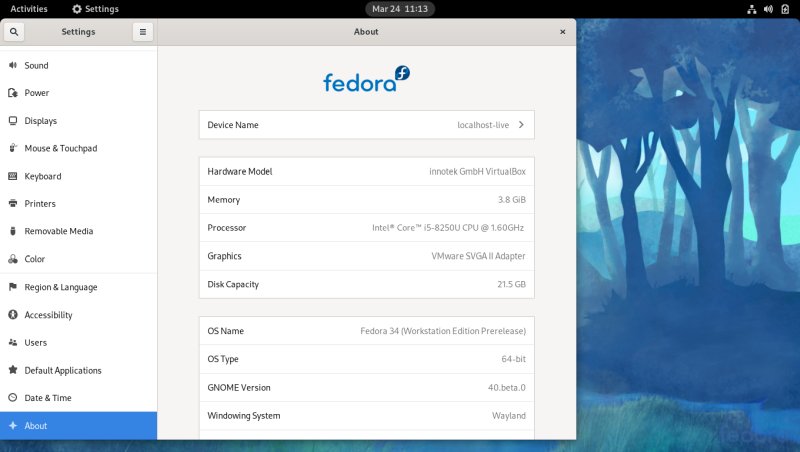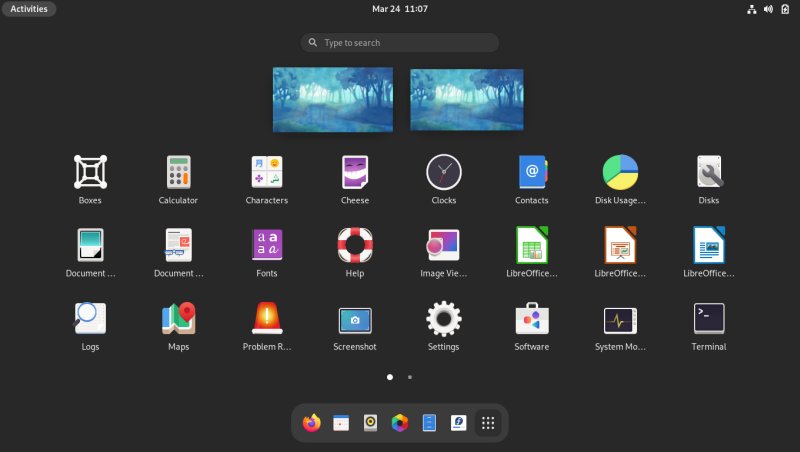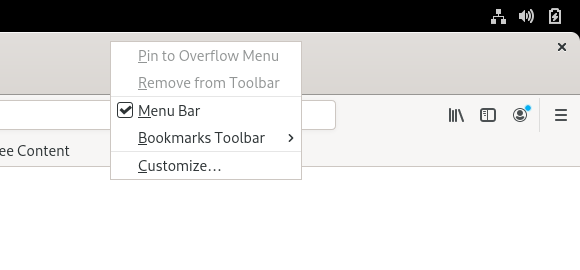

Gnome 40 - The anti-desktop desktop
source link: https://www.dedoimedo.com/computers/gnome-40.html
Go to the source link to view the article. You can view the picture content, updated content and better typesetting reading experience. If the link is broken, please click the button below to view the snapshot at that time.
Updated: March 29, 2021
In a few weeks, Fedora 34 will be released, and alongside it - you will get to use Gnome 40, the next version of this namesake desktop environments. But wait. Gnome 40 has been officially released only a few short days ago, and you can already try it. Ahead of the distro testing season, I thought it would be a neat idea to grab the software and check what awaits the Tux crowds en masse come mid-April. I downloaded the Fedora 34 beta and booted the system.
Going into a review without any expectations or great hope is a good thing for me. My emotional balance will most likely not be upset too much today. After all, for me, Gnome 3 has never delivered. It's always been sub-optimal, introducing complication and confusion into the classic desktop formula through a strange paradigm of would-be visual minimalism and touch-like inefficiency. More mouse clicks = not fun. I don't expect miracles. But who knows, I might actually be surprised. Remember, beta version, things could change. Now, let's proceed. Commence.
Ergonomics? Nope.
The wide range of problems that affected Gnome 3 since early release remains. This makes desktop usage difficult - and less efficient - without modifications. The most noticeable change is the redesign of the Activities view, which shows you the application launcher (dash) and workspaces. The latter have gone horizontal, and the icons are now on the bottom of the screen instead of being aligned to the left edge.




The app palette opens from below - so we've gone from top centric to bottom centric. Why?
This looks nicer - but actually, it is less efficient. Gnome doesn't show you the overview of your open apps or any application shortcuts on its desktop. You need to open Activities - an extra mouse click - before they are shown. And then, you can say launch this or that software. Since the Activities "button" is located in the top-left corner, having a launcher on the left side made sense - you don't need any great mouse movement. Now, you need to move the cursor half across the screen. This wouldn't be a problem if the actual dash was visible all the time, and you consciously moved the mouse toward the icons. Only this way, you have to do a lightweight Z for Zorro motion - left up, right down, swipe, swipe.
Windows buttons
Minimize and maximize are still not shown by default. To enable them, you need a SEPARATE application - Gnome Tweaks - or a horrible command-line trick. This is totally inefficient, yet more mouse clicks. Worse, as I outlined a dozen times over in multiple Fedora reviews, Firefox cannot be minimized, at all, with or without the titlebar. Other windows, right click > minimize. Pointless? Yes, but doable. Firefox? No such option. You cannot minimize the window with the mouse (until you enable the min/max buttons). Yes, this is still true in Gnome 40 in 2021. And no, I don't want to use my keyboard. This is 2021. Every desktop has keyboard shortcuts for power users, that's nothing new nor the point. But every other desktop also lets anyone, including non-techies, use the system via mouse clicks, in a simple, fast and predictable fashion.

Extensions
More complexity. Gnome Tweaks no longer lets you control extensions. There's a new SEPARATE tool for that - not available through dnf from Fedora repos but as a flatpak, through Flathub. So, in Gnome 40, if you want to enable extensions, which most likely is necessary because the desktop won't let you do many basic things, like windows buttons or fonts or whatnot, you now need THREE separate data sources:
- Gnome Tweaks (dnf) for half a dozen changes.
- The Gnome extension (Web interface) in your browser - for me, in Firefox, it wasn't provided through the Mozilla's Add-ons page, so you need to accept a third-party source. Maybe the extension exists there, too, but the official site offered me this version. Toggle the extensions you like to ON. But this is not enough.
- Gnome Extensions (flatpak) to manage extension settings. You will need to configure Flathub as a remote repo first. This requires a command-line trick.


The extensions are not updated side by side with your system, btw. On top of that, in the Fedora 34 beta, none of the extensions were compatible. It's a small matter of changing this or that tag in this or that JSON file, but I couldn't really test any of the tools I needed, which also means I couldn't - or will not be able - to use Gnome even if I want to play around with it. There could also be actual compatibility problems with extensions moving from 3.38 to 40, as previous versions of Gnome often broke extensions.

Other issues
And then, there was a whole bunch of other problems:
- No show desktop or minimize apps icon/button available.
- No desktop icons.
- Cantarell fonts are still meh.
- The fonts still use the Grayscale hinting rather than subpixel (LCD); the latter offers far better results.
- Overall clarity, contrast and colors can be better, friendlier - small things like jaundice-brown folder icons in Files or no distinction between foreground and background windows.
![]()
- The screenshot tool does not save files on Enter.
- Files still doesn't let you right-click > create files.
- And so on ...
Files didn't allow me to change the date format for the Modified column, either. In the past, Files did have the Display section under its preferences, but this does not seem to exist anymore. I installed dconf-editor and tried to make additional tweaks this way, but there was nothing regarding time or date format. Another sad thing is that there are so many other options available, but they are not exposed to the user. Much like Videos, which goes under the binary name of Totem, Files is still Nautilus in the backend and inside dconf and gconf.



Also, notice the (lack of) differentiation between foreground and background windows active/inactive status.
Another issue is the overall theming consistency. After the installation, Fedora 34 Beta popped a dark-themed Gnome 40 tour window. All right, I decided to see what gives, and then this window transformed into a larger, light-themed Fedora tour. What. Most of the focus in it was explaining how to use Touchpad multi-tap, multi-finger swipes. What. How's that a tour of the desktop environment or Fedora? Why would I care about Touchpad? What if I'm running a classic desktop PC?



Desktop scaling
Nope. I couldn't find anything under Settings. Maybe this is a Wayland thing, but nope. Scaling fonts (DPI) did work fine.

Anything good?
Some. Overall, Gnome 40 is a bit more polished, more consistent - compared to earlier versions. The desktop freeze glitch on app search that I encountered so many times before seems to be gone. However, these changes are tiny, and given the fact Gnome 3 has been around for roughly a decade, the overall workspace inefficiency remains a huge blocker.

Conclusion
Gnome 40 is Gnome. Simple. A desktop environment that caters to a weird "minimalistic" model that introduces touch-like inefficiency into the world of classic computing. The naming conventions falsely raises expectations, but it's a standard release, with a few new options, a few small visual changes, and some tweaks behind the scenes. You can't really decouple most of the experience from Fedora.
I wasn't impressed really. Scaling, fonts, overall ergonomics are all off - and slowly getting worse as time goes by. Just setting up the framework to use extensions - so you can have basic desktop functionality present in 100% of all other desktop setups in the world - is frustrating. A total waste of time. I need a dozen steps just to be able to see my application shortcuts all the time. Why bother? However, there's one advantage to Gnome - it's a good indicator of where the future of Linux lies. So a decade from now, the Linux desktop will gently, gracefully make itself completely irrelevant to everyday computing. But hey. I'm on my happy pills. Smiley face, bye bye.
Cheers.
Recommend
About Joyk
Aggregate valuable and interesting links.
Joyk means Joy of geeK